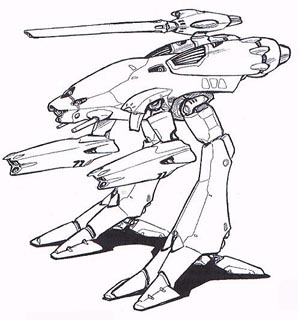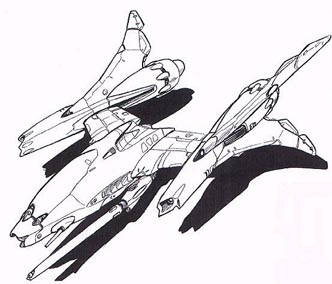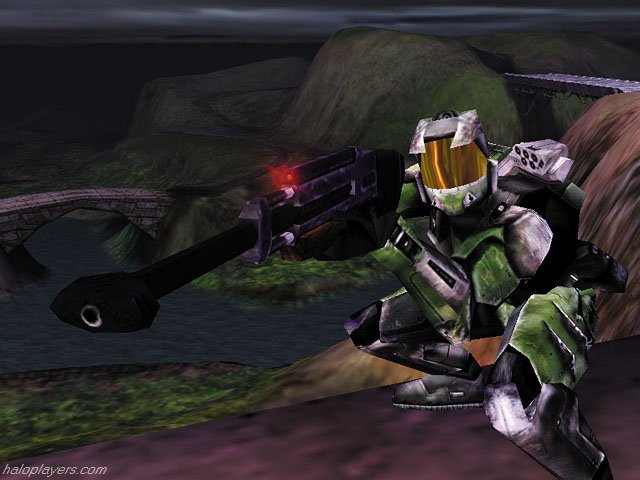Concept Design from Macross Digital Valkyrie
and some magic by RPG P. DAVID BAUGHMAN III ([email protected])
DANIEL HENWOOD ([email protected])
Kenneth Olson
**New History and stats By Donte Hill
** rewokrd for macross 2055


The first result of this program was the Variable Glaug, a transforming fighter built on the mission model of UN Variable Fighters. Well armed and nimble, the Variable Glaug was equipped with a fighter configuration with performance superior to the Raulon-ve, as well as two ground fighting modes (a Terran-style Battloid mode, and a Zentraedi-style Pod configuration). While the Variable Glaug was a fairly successful mecha design, although its micron-size cockpit meant that it could only be piloted by Terrans.
Despite its limited success, Vrlitwhai Kridanik (now commander in chief of all UN Armed Forces) authorized a project to adapt the basic design to the Zentraedi physiology. Almost immediately it was discovered that the Battloid mode of the Variable Glaug could not be supported in the new design, due to size constraints placed on the hull by the substantially larger cockpit. Rather than design a new third configuration, the decision was made to discard the Battloid mode entirely and design the new fighter as a two-mode craft. For the most part the airframe of the Variable Glaug was maintained; it was already a proven design, and did not require any extensive modifications. Some streamlining was added to the forward upper superstructure after the replacement of cockpit assembly, and the hands (rendered obsolete by the removal of the Battloid configuration) were removed, along with their accompanying actuators - an additional laser cannon replaced the assembly.
After a successful period of testing, the new vehicle, dubbed the Neo-Glaug, was officially launched into UN service, replacing uprated Glaug and Raulon-ve pods. Because of security problems involving the Anti-UN Rebels, only Officers and senior NCOs are authorized to pilot the Neo-Glaug, a policy that has resulted in many of the older Raulon�ve fighter pods remaining in service. As of 2048, the Neo Glaug is still in service.
Like the Neo Glauge that had be reviesd Marine comanndesr saw this that the same units could be refited to fit the role that most MEU were lacking heavy fire suppoert and fast strike the Marines Got their hands and a few of the early prototypes. In a few short monthes the the had rebulit a few units using current technology from project super nova and turned out a unit that surpassed the capabilties of the Neo units already in serivce.
With the Neo unites in service and not yet having a name for the unit it was dubed the "COBRA" after the old US Marine AH-1 COBRA, filling the gaps the plauged many marine operations.
Manufacture:Shinsei Industries
Crew: Terran type:Two pilot wearing Tactical life support System + polit/navigator
Crew: Zentraedi type NEO Glauge C "COBRA": One Full-Size Zentraedi in Light Combat Armor
Location MDC
* Nose Sensor Cluster 75
Upper Arms (2) 75 each
Weapon Arms(2) 120 each
Impact Cannons(2) 100 each
Legs (2) 300 each
Main Engine Thrusters (2) 200 each
Wings (4) 175 each
Particle Beam Cannon 75
Pilots Compartment 250
** Main Body 400
Rapid Fire Lasers (2) 50 each
***Pinpoint Barrier Sheild 100
NOTES:
* Destroying the nose sensor cluster of the VF-Z1 will knock out the mecha's major sensor systems, including all of the optics systems (infrared, night vision, thermal). Radar and communications will be unaffected.
** Depleting the MDC of the main body will destroy the mecha. Pod will automatically eject from doomed f befor it explodesighter
***The PPBS regenerates at a rate of 50 MDC preround Even if completely destroyed the shield will regenerate with in 2 melee rounds
RUNNING, BATTLEPOD CONFIGURATION:
175 kph
LEAPING, BATTLEPOD CONFIGURATION:
100 ft (15 m) high or 140 ft (21 m) long without thrusters.
FLYING, BATTLEPOD CONFIGURATION:
Mach One (670 mph/1072 kmph) maximum speed limit in an Earth-like atmosphere. Can also hover in place indefinitely.
FLYING, FIGHTER CONFIGURATION:
Max level speed at sea level : 2465 kph (Mach 2.3)
Max level speed at 10,000 meters: Mach 6.0
Max level speed above 10,000 meters: Mach 25+
Stall speed : 125 kph
Initial climb rate : over 40000m per minute
Service ceiling : Can reach orbit
MAX ENGINE THRUST:
70,500 kg x2 in an atmosphere, 75,950 kg x2 in space. The maximum thrust is automatically limited in an atmosphere due to coolant problems with the optional air intake systems for the engines.
STATISTICAL DATA:
HEIGHT:
8.12m in Battlepod configuration.
4.04m in Fighter configuration.
WIDTH:
6.91m at shoulders in battlepod configuration.
15.36m with wings at maximum extension.
LENGTH:
15.23m in Battlepod configuration.
19.08m in fighter configuration.
WEIGHT:
20,000 kg empty.
PHYSICAL STRENGTH:
Equal to a P.S. of 75
CARGO:
Small compartment behind pilot's seat for personal belongings in addition to the PA storage compartment
POWER PLANTS:
Two 70,500 kg Shinnakasu Industry/Pratt & Whitney/Rolls Royce FF-2545AS thermonuclear turbine engines, designed for dual atmosphere/space use with optional concealed air intakes for use in an Earth-type atmosphere. Two 2-dimensional independentent convergent/divergent exhaust are equipped on the FF-2530AS for greater maneuverability and V/STOL performance. In addition, several Pratt & Whitney HMM-9J high-maneuverability vernier thrusters are mounted on the wingtips, vertical stabilizers, nose, and other key locations for added performance.
one FRF 500 Fusion Reactor for Paritcal Cannon
RRG PB-19 PARTICLE BEAM CANNON: Designers felt that the main weapon should be based off a standard Zentraedi design. To this end they upgraded the PB-19 found on the Glaug Zentraedi Officer Pod. The PB-19, unlike its predecessor, is able to fire up to fifty times per minute to a range of 10 kilometers. This weapon is able to destroy large numbers of enemys at extreme ranges without the necessity of ammunition.
PRIMARY PURPOSE: Heavy Assault
SECONDARY PURPOSE: Surgical Strikes
RANGE: 10 km
DAMAGE: 6D6*10 MDC
RATE OF FIRE: Equal to the pilots total hand to hand attacks up to 8 times per melee
PAYLOAD: Unlimited
2 x RRG PBC-12b PARTICLE BEAM CANNONS: Each weapons arm mounts two PBC-12B cannons. Each cannon fires out to 2.4 kilometers. These cannons can fire at twice the rate but only at 75% of the range and 50% of the damage potential. Each cannon can rotate 30 degrees to each side in tandem, rotate up to 10 degrees to each side, and -10 to +30 degrees independently.
PRIMARY PURPOSE: Assault
SECONDARY PURPOSE: Anti-Mecha
RANGE: 3km
DAMAGE: 5d10+25 for each single shot or 10d10+25 for each dual shots. For GM's sanity this could be translated as 3D4*10 for each single or 6D6*10 for each dual.
RATE OF FIRE: Four times per melee for each gun. The guns can fire at 1/2 damage however the rate of fire is doubled.
PAYLOAD: Unlimited
HUGHES LG-2g IMPACTCANNONS(2): These two small, single-barrel cannons were selected to The cannons are not best used for anti-mecha combat, but are better suited for engaging infantry and lightly armored vehicles. the guns are located on either side of the main cockpit assembly.
PRIMARY PURPOSE: Anti-Personnel
SECONDARY PURPOSE: Defence
RANGE: 2 miles (3.2 km)
DAMAGE: 3D6 per single blast .
RATE OF FIRE: One Volley of one or both AutoCannons. One Volley counts as one attack
PAYLOAD: unlimited
2 x GU-21 THREE-BARRELED 35MM GUN POD: firing 1400 rounds per minute, 1600 round capacity. Ammunition is a mix of Tungsten-coated depleted Uranium Armor Piercing Spin-Stablized Discarding Sabot (APSSDS), High Explosive Armor Piercing (HEAP) and tracer rounds. However, due to its shorter barrel, accuracy, penetration, and range are appreciably reduced. Both guns are mounted in the weapon arms underneath the
PB-12c.
PRIMARY PURPOSE: Assault
SECONDARY PURPOSE: Anti-Mecha
RANGE: Armor Piercing Spin Stablized Discarding Sabot Rounds (APSSDS) 3500 feet (1100 m), High Explosive Armor Piercing, 4000 ft (1200m)
DAMAGE: HEAP 4d6 short burst, 1d4*10 medium burst, 2d4*10 full melee burst.
RATE OF FIRE: Single shots or bursts equal to the combined attacks of the pilot.
PAYLOAD: 200 short bursts, 100 medium, or 50 full melee
BIFORS ALL-ENVIRONMENT HIGH-MANEUVERABILITY MINI-MISSILE CLUSTERS: The back of the VF-Z1 are equipped with two concealed missile launcher bays, that can each hold up to 24 new high-maneuverability mini-missiles from Bifors in each bay. (NOTE: These are NOT the medium-range versions of the high-maneuverability missiles seen in Macross Plus #1). When armed, the missile launcher assembly rises out of the back units, allowing all 24 missiles to be fired at once if necessary. The missiles can be fired in both modes; fighter,battlepod . Any type of mini-missile can be used in the launchers, but usually only the Bifors high-maneuverability mini-missiles are used.
PRIMARY PURPOSE: Assault
MISSILE TYPES: Any type of standard UN Spacy Mini-Missile, or the new Bifors high-maneuverability mini-missiles.
RANGE: 1 mile (1.6 km).
DAMAGE: 1d4X10 MD
RATE OF FIRE: Volleys of 1-24 missiles per launcher, per round. One volley counts as one attack. If necessary, all 48 missiles (!) can be fired in a single round by expending two attacks.
BONUSES: +3 to strike, +1 to dodge.
PAYLOAD: 24 missiles per launcher; 48 total.
HOWARD PBS-03F PIN-POINT BARRIER SYSTEM: The VF-Z1 is equipped with a mecha-scale pinpoint barrier system for defense. The system can generate a single pinpoint barrier that can be moved anywhere on the mecha and used as a shield against incoming attacks. The barrier provides 100 MDC of protection, and regenerates at a rate of 50 MDC per round when damaged. Even if destroyed by combined attacks, the shield will regenerate itself within 2 rounds. In order to use the shield, the pilot must make a successful parry roll to intercept an incoming attack.
Primary Purpose: Defense
Protection: 100 MDC total
Regeneration Rate: 50 MDC per round.
Size: The barrier can be up to 10 ft (3 m) in diameter.
Duration: Unlimited.
WEAPON HARD POINTS: (2) The Neo-Glaug is equipped with 2 hard points for carrying extra ordinance of missiles, or similar sized weapons or warfare packages. Each of the small inner wings has a hardpoint on it, which can carry outboard weapons or stores.
NOTE: Due to the location of the hard points, ALL missiles must be fired or ejected before the Neo-Glaug can convert into Pod mode.
LONG RANGE MISSILES
Primary Purpose: Heavy Assault
Secondary Purpose: Anti-Spacecraft
Missile Types: Any type of UN Spacy Long Range Missile can be used.
Range: Varies with missile type.
Damage: Varies with missile type.
Rate of Fire: Volleys of 1 or 2 missiles per attack.
Payload: One per hardpoint; 2 maximum.
MEDIUM RANGE MISSILES
Primary Purpose: Assault
Secondary Purpose: Anti-Mecha
Missile Types: Any type of UN Spacy Medium Range Missile can be used.
Range: Varies with missile type.
Damage: Varies with missile type.
Rate of Fire: Volleys of 1, 2, 4 or 6 missiles per attack.
Payload: Three per hardpoint; up to 6 maximum.
SHORT RANGE MISSILES
Primary Purpose: Assault
Secondary Purpose: Anti-Mecha
Missile Types: Any type of UN Spacy Medium Range Missile can be used.
Range: Varies with missile type.
Damage: Varies with missile type.
Rate of Fire: Volleys of 1 to 10 missiles per attack.
Payload: Five per hardpoint; up to 10 maximum.
HAND TO HAND COMBAT: If necessary, the pilot of the Neo-Glaug can engage in melee combat rather than use a weapon. Although not designed for hand-to-hand combat, the Neo-Glaug is fairly powerful and can do significant damage if it connects.
DAMAGE:
Restrained Punch: 1D6 M.D.
Full Strength Punch: 3D6 M.D.
"Booster" Punch: 4D6 M.D. (counts as two attacks)
Kick: 1D6 M.D.
Leap Kick: 2D6 M.D.
Body Flip/Throw: 1D6 M.D.
Body Block/Tackle: 2D6 M.D.
Stomp: 1D6 M.D. (only effective against small objects)
STANDARD EQUIPMENT FOR THE VF-Z1:
ACTIVE STEALTH SYSTEM: The VF-Z1 is equipped with a revolutionary stealth system that when activated renders the craft almost invisible to standard sensors such as radar. Unlike passive stealth systems like those used by the VF-17 Nightmare or the old USAF F-117, the VF-Z1's stealth system is an ACTIVE stealth that actually bends radar waves around the mecha rather than reflecting them. When activated, this system gives the VF-Z1 a +3 on initiative and a +1 to strike at all times.
AUTO-PILOT: The VF-Z1 is equipped with a computerized auto-pilot, allowing the pilot to relax or even sleep during long voyages. The auto- pilot can be programmed with a single destination or a complex flight plan involving multiple speeds, directions, and destinations. The onboard computer will alert the pilot when the fighter is near its destination, and can also be set to automatically signal when sensors detect objects near the mecha. The auto-pilot was designed with long intra-system space journeys in mind.
COMBAT COMPUTER: The combat computer tracks and identifies specific enemy targets, and has a database of over 15,000 images stored in memory. The computer can identify and track up to 300 targets simultaneously.
EXTERNAL AUDIO PICKUP: Range: 300 ft (91.5 m). A sound amplification system that can pick up normal conversation up to 300 feet away.
HEAT AND RADIATION SHIELDS: Special shielding prevents the penetration of life threatening head and radiation. A radiation detection and alarm system are linked with the shields and will sound an alarm if there is a rupture in the shields and what the levels of radiation are.
HOMING SIGNAL: The escape pod of the VF-Z1 is equipped with a homing device that enables rescue teams to locate a disabled craft or ejected life pod. The range of the signal is 400 miles (640 km).
LASER TARGETING SYSTEM: Range: 100 miles (160 km). Used for increased accuracy in the striking of enemy targets and is partly responsible for the mecha's strike bonus.
LOUDSPEAKER: A loudspeaker system is built into the craft, which can be used to amplify the pilot's voice up to 90 decibels.
OPTICS: INFRARED: Range: 2000 feet (610 m). This optical system projects a beam of infrared light that is invisible to the normal eye, but detectable by the mecha's sensors. The system allows the pilot to detect hidden/concealed objects by their IR reflectiveness. The beam will be visible to anyone with IR sensitive optics, however.
OPTICS: NIGHTVISION: Range: 2000 feet (610 m). A passive light image intensifier that emits no light of its own, but relies on ambient light which is electronically amplified to produce a visible picture.
OPTICS: THERMAL IMAGER: Range: 2000 feet (610 m). A passive optical heat sensor that detects infrared radiation projected by warm objects and converts that data into a false-color visible image. The system enables the pilot to see in the dark, in shadows, and through smoke, and also adds a +10% bonus to pilots using a tracking skill.
RADAR. 250 mile range.
RADIO/VIDEO COMMUNICATION: Long range, directional communications system with satellite relay capabilities. Range: 600 miles (960 km) or can be boosted indefinitely via satellite relay.
SELF-DESTRUCT: To prevent capture of an advance variable fighter by the enemy, the pilot can activate the VF-Z1 self-destruct system, which will cause the fighter to explode after a delay of up to 60 minutes (time is set by the pilot). The explosive damage is contained within a 20 foot (6 m) area and inflicts 1D6x10 M.D. to everything within the radius of the explosion. All internal systems are obliterated. The escape pod will be automatically ejected prior to the explosion unless the pilot overrides the ejection sequence.
STANDARD SURVIVAL KIT: All UN Spacy Variable Fighters come equipped with a portable survival kit. Inside the small reinforced box is a medium-sized flashlight, two hand flares, one rocket flare, a compass, infrared distancing binoculars, a small mirror, a pocket knife, dehydrated and concentrated food (can be stretched into a five day supply for one person) and basic first aid items (aspirin, bandages, disinfectants, etc.)
TACTICAL LIFE SUPPORT SYSTEM: The VF-Z1 cockpit is pressurized, and also provides additional air feeds to the pilot's flight suit that provides him with pressurized breathing. The flight suit also contains an upper and lower g-suit that promotes blood circulation even during high-g turns, thus decreasing the possibility of pilot's blacking out in combat.
VIRTUAL ENVIRONMENT COCKPIT: The VF-Z1 is equipped with an innovative cockpit layout that provides monitors below and around the pilot in addition to the HUD cockpit dome. In flight, these monitors display what is below and behind the aircraft, giving the pilot a tremendous field of view that is unparalled by any other aircraft (with the possible exception of the YF-21's brain-direct imaging system). This wide view in addition to the combat computer's cockpit overlays give the VF-Z1 a +1 to dodge and initiative rolls in addition to any other bonuses.
CHAFF AND FLARE DISPENSERS: 12 chaff and 12 flares are stored in the lower legs
--------------------------------------------------------------------------------
COMBAT BONUSES FOR VF-Z1 FIGHTER TRAINING:
Advanced training for pilots specializing in the VF-Z1
4 attacks per melee (plus those of the pilot)
Add one additional action/attack at levels two, five, seven, and ten.
+2 on initiative (+5 when using Active Stealth System, see above)
+3 to strike (+4 when using Active Stealth System, see above)
+4 to parry
+4 to dodge in solder mode, +6 BattlePod mode, +8 in jet mode (includes bonus from Virtual Environment Cockpit, see above)
+3 to roll with a punch or fall with an impact, reducing damage by half.
+3 to leap dodge. A leap dodge is an automatic dodge which causes no loss of attacks per melee. The new generation VF are so maneuverable that the pilot can dodge an attack while moving to counterattack an enemy.
Critical strike same as pilot's hand-to-hand.
Body block/tackle/ram - 2D4 M.D. plus a 50% chance of knocking an opponent down, causing him to loose initiative and one attack that melee round.
--------------------------------------------------------------------------------
REFERENCES USED IN THIS DESIGN
"Doe's All The Worlds' Mecha Guide: VF-Z1 COBRA"

